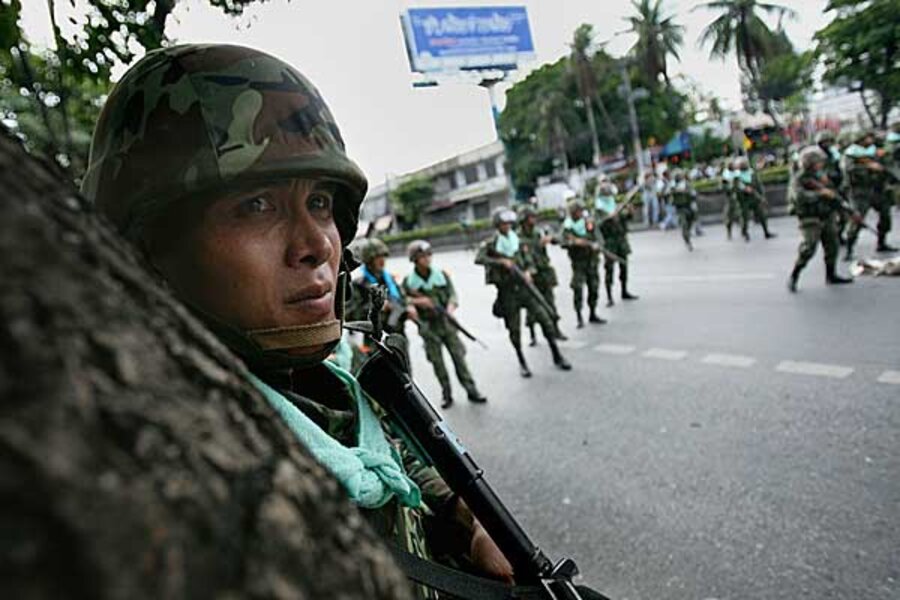Clashes with red shirt protesters create 'war zone' in downtown Bangkok
Loading...
Little more than a week after it seemed Thailand’s antigovernment protestors were on the brink of an agreement with the nation’s ruling party, violent protests erupted Friday leaving at least five additional people dead and 81 injured. The two months of violence have now killed 34 people.
The latest wave of violence began after a renegade Thai general who was supporting the red shirts was shot in the head Thursday night, after Thai military forces surrounded the so-called "red shirt" antigovernment protesters’ camp in the heart of Bangkok in an attempt to seal it off and prevent reinforcements from entering.
Protesters allege that a Thai Army sniper tried to assassinate Maj. Gen. Khattiya Sawasdipol, a vocal critic of the government. Military officials deny that they had any involvement in the shooting. Sawasdipol, meanwhile, remains in critical condition.
IN PICTURES: Top 10 unusual protests
Multiple witnesses described the ensuing violence that erupted between military forces and protesters as turning downtown Bangkok into a “war zone.” Red shirts overturned a police van and set it ablaze while others shot fireworks at the police. Among the injured Friday were two Thai journalists who were each shot in the leg, along with a Canadian television cameraman in serious condition after being shot three times.
“The [government] troops were firing a considerable number of rounds into a park, on the other side of which the protesters have control,” said the BBC’s Alastair Leithead in Bangkok. “There are areas of confrontation all around the center of Bangkok. It's heavily militarized. The troops have been firing rubber bullets, tear gas, and live rounds.”
Thaksin calls for negotiations
The protesters want the current prime minister to resign and hold immediate elections. The red shirts support former Thai Prime Minister Thaksin Shinawatra, who was ousted in a 2006 coup and now lives in self-imposed exile in Dubai. They argue that the current political system is susceptible to undue influence from the military and political elites.
Mr. Thaksin on Friday called on Prime Minister Abhisit Vejjajiva to begin negotiations with protesters and peacefully resolve the situation. In a statement, Thaksin said Mr. Abhisit should "negotiate with all sides in the country to find an acceptable and genuine reconciliation plan to establish true democracy and justice in Thailand and move the country forward."
Analysts say it may be some time before calm returns to what was once one of the most stable nations in the region. “Whenever the next election comes, things will get really chaotic,” Paul Chambers, a professor at Germany's Heidelberg University and an expert on Thailand's armed forces, told The Wall Street Journal. “There could be pandemonium on a much wider scale.”
Red shirts dwindling
As the government increases pressure and boosts security forces surrounding the main red shirt camp in Bangkok’s business district, the number of protesters has fallen from 10,000 to about 5,000, according to Al Jazeera, though it is difficult to calculate exact numbers. Army officials say they do not plan to raid the camp, but they will stop supplies and people from entering it.
“Information very sketchy as the fighting is going on all around not just in the protest area,” said Al Jazeera's on-scene reporter Aela Callan. She added that the fighting was spreading outside the red shirt camps as the demonstrators tried to get reinforcements.
Along with injury of a Canadian television cameraman from the France 24 news channel, Thai journalists from Matichon newspaper and Voice-TV cable television station were also shot, according to Agence France-Presse. A Japanese cameraman was among 25 killed when clashes broke out between the red shirts and police on April 10, which was until today the worst episode of violence.
As the fighting continues, Bangkok has curtailed public transportation, reports the Daily Telegraph. Many of the city’s residents are also opting to stay at home to avoid the clashes.
IN PICTURES: Top 10 unusual protests
Related:





